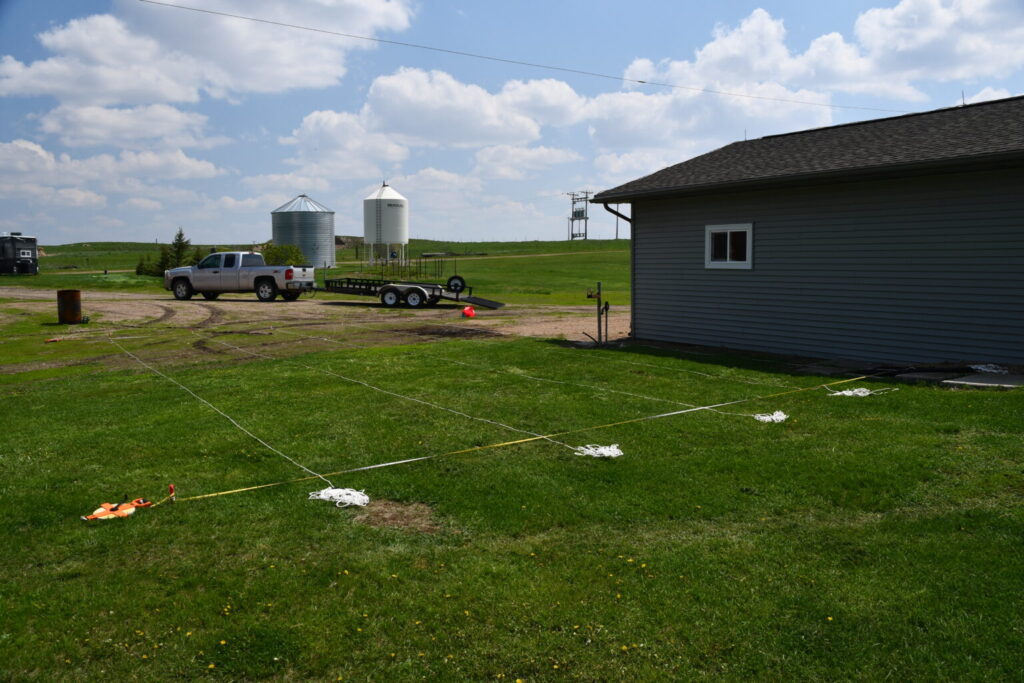Grid lines were laid out for a potential fossil dig at a home in northwest North Dakota. Mammoth teeth were found 1988 while preparing the site for the construction of the garage at the right. (Photo courtesy of the North Dakota Geological Survey)
Some mammoth bones have been gnawing at North Dakota State Geologist Ed Murphy for more than 35 years.
Murphy on Tuesday described for the North Dakota Industrial Commission how he became aware of a find of mammoth bones in 1988. He updated the commission, which oversees the North Dakota Geological Survey, because his department, in cooperation with the State Historical Society, plans to excavate part of the site and may need to request money from the state to finish the job.
In 1988, Murphy said he received a report of a homeowner finding some woolly mammoth bones while digging a foundation for a garage in northwest North Dakota. Murphy did not disclose a more precise location of the find.
Ed Murphy, left, state geologist, speaks during a meeting of the North Dakota Industrial Commission next to North Dakota Agriculture Commissioner Doug Goehring on Aug. 27, 2024. (Michael Achterling/North Dakota Monitor)
The family had already sent a couple of teeth to North Dakota State University to verify that they had come from a woolly mammoth, prehistoric beasts that lived in what is now North Dakota during the Pleistocene Epoch, commonly called the Ice Age.
Weeks later, word got to Murphy that teeth had been confirmed as coming from a mammoth and he went to the site the next day. But by this time, the foundation had been poured and the garage built.
Murphy said he asked the homeowner if he would be willing to have the garage moved and foundation busted up so there could be an archeological dig. Murphy said the homeowner was willing, as long as the garage was restored the next month.
But Murphy was not able to find the people or the money to make that happen.
In December, 35 years later, Murphy started going through his notes from that visit. After the holidays, he contacted the person who now owns the home and attached garage.
While the property had changed hands, the new owner knew people from the garage construction crew, who had shared that there may be a mammoth under the garage.
So it was not a big surprise when Murphy reached out. The homeowner agreed to a test dig near the garage. Murphy said the small pit revealed some bone fragments and pieces of tusk in the backfill for the garage slab. Digging a little deeper revealed three undisturbed bones.
Mammoth bone fragments were found during a test dig in May 2024 at residence in northwest North Dakota. (Courtesy of North Dakota Geological Survey)
Margaret Patton, a research archaeologist with the Historical Society, also used ground-penetrating radar at the site.
“It doesn’t make beautiful pictures,” Patton said of the radar, but it does detect anomalies, something different from the soil around it, that corresponded to where construction workers had reported bones being found.
Murphy said a crew will return to the garage for a larger dig — about 6 feet by 6 feet and down at least 30 inches — in mid-September.
“If they uncover a big rock, I’ll be sad, but I’m hoping that it really will be bigger mammoth bones,” Patton said.
Patton said the September dig should provide a better idea of the potential for the site and the potential cost. There may need to be a budget request for the Legislature when it meets in January so work can continue into 2025.
While there have been woolly mammoth tusks and other bones found in the state, “a skeleton or a nearly full skeleton would be a first” for North Dakota, Murphy said.
A mammoth bone is shown still embedded in the ground after a test dig in May 2024 at a residence in northwest North Dakota. (Photo courtesy of the North Dakota Geological Survey)
Several species of mammoth lived in North America, including the woolly mammoth and the Columbian mammoth, according to the North Dakota Geological Survey. They lived alongside other animals like saber-toothed tigers and giant sloths before going extinct in the area about 10,000 years ago.
In 2023, coal miners near Beulah discovered a 7-foot tusk of an ancient mammoth.
“There we had a beautiful tusk that was really in great shape,” Murphy said. In addition, 18 other bones or parts of bones were found.
Murphy said fossil bones like the tusk are soft and need to be encased in plaster to be safely removed. Then it’s a monthslong process to stabilize the fossil.
Murphy said he is hopeful for the new dig site, but there are no guarantees.
“It still will be a gamble of what’s under there,” he said.
North Dakota Monitor is part of States Newsroom, a nonprofit news network supported by grants and a coalition of donors as a 501c(3) public charity. North Dakota Monitor maintains editorial independence. Contact Editor Amy Dalrymple for questions: info@northdakotamonitor.com. Follow North Dakota Monitor on Facebook and X.

